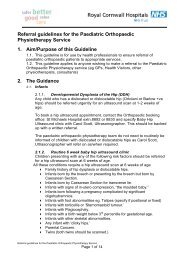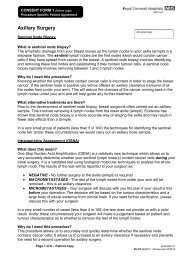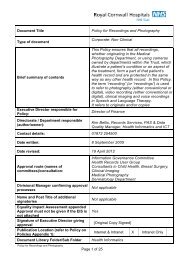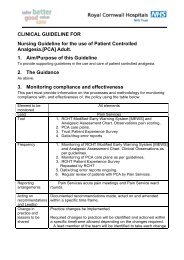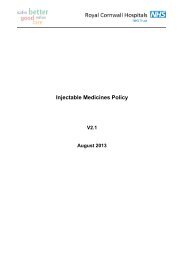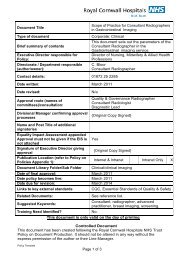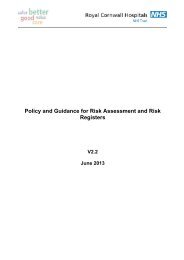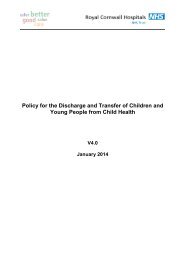Catheterisation in Adults - the Royal Cornwall Hospitals Trust ...
Catheterisation in Adults - the Royal Cornwall Hospitals Trust ...
Catheterisation in Adults - the Royal Cornwall Hospitals Trust ...
You also want an ePaper? Increase the reach of your titles
YUMPU automatically turns print PDFs into web optimized ePapers that Google loves.
Ca<strong>the</strong>ters should be re moved wherever cl<strong>in</strong>ically possible, follow<strong>in</strong>g <strong>in</strong>dividual assessment,which takes <strong>in</strong>to accou nt <strong>the</strong> patie nt’s condition and <strong>in</strong> co llaboration with <strong>the</strong> healthcareteam. Removal of <strong>the</strong> ca<strong>the</strong>ter sh ould be considered at each review, unless <strong>the</strong> patient'scondition requires cont<strong>in</strong>ued ca<strong>the</strong>terisation for cl<strong>in</strong>ical benefit and/or quality of life.Follow<strong>in</strong>g removal, <strong>the</strong> patient’s condition should be monitored. A bladder scan ( portable)should be performed <strong>in</strong> <strong>the</strong> first few hours to measure for post-void residual ur<strong>in</strong>e, becauseur<strong>in</strong>e retention is possible follow<strong>in</strong> g removal of ca<strong>the</strong>ter and action should be t aken asnecessary (Appendix 6). Post-ope ratively, <strong>the</strong> ca<strong>the</strong>ter should be removed as soon ascl<strong>in</strong>ically possible. Attempts should be made to avoid removal of an <strong>in</strong> dwell<strong>in</strong>g ca<strong>the</strong>ter on<strong>the</strong> day of discharge or transfer from hospital.4.28 Adverse EventsConsideration should be given to user sensitisation to lat ex products, especially <strong>in</strong> thosepatients with sp<strong>in</strong>a bifida as <strong>the</strong>y are a t high risk due to repeated exposurewww.asbah.org/libraryAutonomic dysreflexia is a serious life threaten<strong>in</strong>g condition that affects people with sp<strong>in</strong>alcord <strong>in</strong>jury at or above t he level of <strong>the</strong> 6th thoracic vertebrae. Bladder problems are one of<strong>the</strong> most common causes of this condition (Appendix 7).Lidoca<strong>in</strong>e based lubricat<strong>in</strong>g gels should not be used dur<strong>in</strong>g a ca<strong>the</strong>terisation procedure <strong>in</strong><strong>the</strong> follow<strong>in</strong>g circumstances:a) If <strong>the</strong> patient states <strong>the</strong>y have an allergy/hypersensitivity to any of <strong>the</strong> active<strong>in</strong>gredients with<strong>in</strong> <strong>the</strong> product.b) If <strong>the</strong> patient has noticeable abrasions and lesions on <strong>the</strong> penis or urethral orifice.Local anaes<strong>the</strong>tics should not be applied to a traumatised urethra as <strong>the</strong> drug maybe so rapidly absorbed that a systemic, ra<strong>the</strong>r than a local, reaction is produced(BNF 2012). These could <strong>in</strong>clude confusion, respiratory depression and convulsions;hypertension; and bradycardia (may lead to cardiac arrest).c) Nurs<strong>in</strong>g assessment prior to adm<strong>in</strong>istration should <strong>in</strong>clude identification of patients at<strong>in</strong>creased risk of systemic effects and check<strong>in</strong>g for possible drug <strong>in</strong>teractions.d) All medical devices and medic<strong>in</strong>al products conta<strong>in</strong><strong>in</strong>g chlorhexid<strong>in</strong>e have beenidentified as be<strong>in</strong>g a risk for anaphylactic reaction. HCP should ensure that anyknown allergies are recorded <strong>in</strong> <strong>the</strong> patient notes and report any adverse events to<strong>the</strong> MHRA (MDA/2012/075)http://www.mhra.gov.uk/Publications/Safetywarn<strong>in</strong>gs/MedicalDeviceAlerts4.29 Bladder & Bowel Specialist ServiceThis is a sp ecialist service, which of fers professional advice, guidance a nd <strong>in</strong>formation on<strong>the</strong> promotion and management of cont<strong>in</strong>en ce; and fa cilitates best practice <strong>in</strong> cont<strong>in</strong>encecare for faecal and ur<strong>in</strong>ary <strong>in</strong>cont<strong>in</strong>ence, <strong>in</strong>clud <strong>in</strong>g enuresis, and related bladder and bowelproblems for children and adults.For any fur<strong>the</strong>r <strong>in</strong>formation or feedcontact via:back on <strong>the</strong> contents of this guidel<strong>in</strong>e, please makeBladder & Bowel Specialist ServiceSt Austell Community HospitalPorthpean RoadSt AustellPL26 6ADTel: 01726 29104212 of 16




